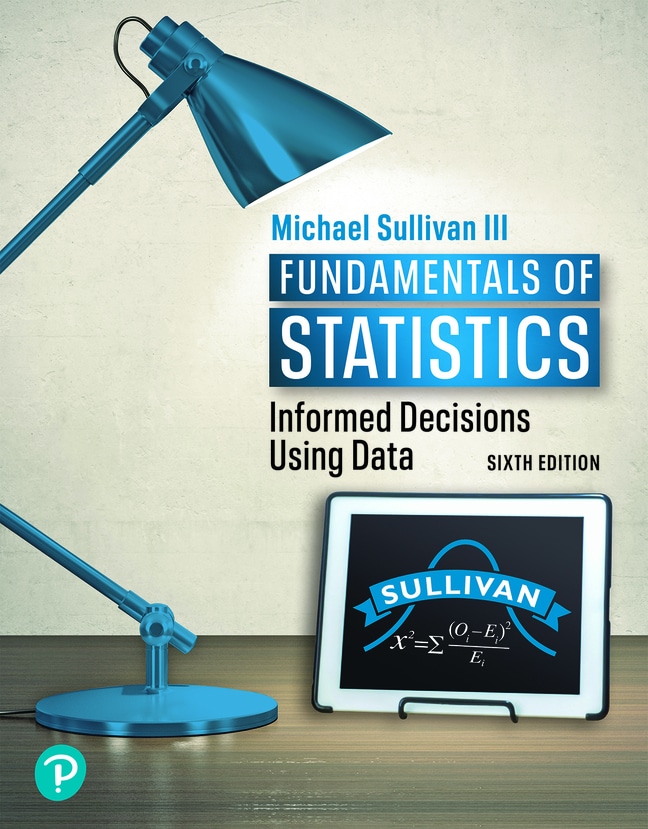
Fundamentals of Statistics, 6th edition
- Michael Sullivan

- Listen on the go
Learn how you like with full eTextbook audio
- Find it fast
Quickly navigate your eTextbook with search
- Stay organized
Access all your eTextbooks in one place
- Easily continue access
Keep learning with auto-renew
Fundamentals of Statistics, 6th Edition helps you connect statistical concepts with an approach that's taken right from the author's own classroom. Mike Sullivan draws on his passion for both statistics and teaching to show that statistics is connected not only in concepts, but to the world at large. This brief version of Statistics: Informed Decisions Using Data pulls his ideas and strategies into a wealth of new and updated exercises, examples and much more. By utilizing the latest statistical software, students can focus on building conceptual understanding rather than memorizing formulas. All additional resources were also created by Mike for his classroom and are available to help every student succeed and stay engaged.
Published by Pearson (August 18th 2021) - Copyright © 2022
ISBN-13: 9780137377022
Subject: Introductory Statistics
Category:
- Preface to the Instructor
- Resources for Success
- Applications Index
I. GETTING THE INFORMATION YOU NEED
- 1. Data Collection
- 1.1 Introduction to the Practice of Statistics
- 1.2 Observational Studies versus Designed Experiments
- 1.3 Simple Random Sampling
- 1.4 Other Effective Sampling Methods
- 1.5 Bias in Sampling
- 1.6 The Design of Experiments
- Chapter 1 Review
- Chapter Test
- Making an Informed Decision: What College Should I Attend?
II. DESCRIPTIVE STATISTICS
- 2. Summarizing Data in Tables and Graphs
- 2.1 Organizing Qualitative Data
- 2.2 Organizing Quantitative Data
- 2.3 Graphical Misrepresentations of Data
- Chapter 2 Review
- Chapter Test
- Making an Informed Decision: Tables or Graphs?
- 3. Numerically Summarizing Data
- 3.1 Measures of Central Tendency
- 3.2 Measures of Dispersion
- 3.3 Measures of Central Tendency and Dispersion from Grouped Data
- 3.4 Measures of Position and Outliers
- 3.5 The Five-Number Summary and Boxplots
- Chapter 3 Review
- Chapter Test
- Making an Informed Decision: What Car Should I Buy?
- 4. Describing the Relation between Two Variables
- 4.1 Scatter Diagrams and Correlation
- 4.2 Least-Squares Regression
- 4.3 The Coefficient of Determination
- 4.4 Contingency Tables and Association
- Chapter 4 Review
- Chapter Test
- Making an Informed Decision: Relationships among Variables on a World Scale
III. PROBABILITY AND PROBABILITY DISTRIBUTIONS
- 5. Probability
- 5.1 Probability Rules
- 5.2 The Addition Rule and Complements
- 5.3 Independence and the Multiplication Rule
- 5.4 Conditional Probability and the General Multiplication Rule
- 5.5 Counting Techniques
- 5.6 Simulating Probability Experiments
- 5.7 Putting It Together: Which Method Do I Use?
- Chapter 5 Review
- Chapter Test
- Making an Informed Decision: The Effects of Drinking and Driving
- 6. Discrete Probability Distributions
- 6.1 Discrete Random Variables
- 6.2 The Binomial Probability Distribution
- Chapter 6 Review
- Chapter Test
- Making an Informed Decision: Should We Convict?
- 7. The Normal Probability Distribution
- 7.1 Properties of the Normal Distribution
- 7.2 Applications of the Normal Distribution
- 7.3 Assessing Normality
- 7.4 The Normal Approximation to the Binomial Probability Distribution
- Chapter 7 Review
- Chapter Test
- Making an Informed Decision: Stock Picking
IV. INFERENCE: FROM SAMPLES TO POPULATION
- 8. Sampling Distributions
- 8.1 Distribution of the Sample Mean
- 8.2 Distribution of the Sample Proportion
- Chapter 8 Review
- Chapter Test
- Making an Informed Decision: How Much Time Do You Spend in a Day . . . ?
- 9. Estimating the Value of a Parameter
- 9.1 Estimating a Population Proportion
- 9.2 Estimating a Population Mean
- 9.3 Putting It Together: Which Method Do I Use?
- 9.4 Estimating a Population Standard Deviation (eText)
- 9.5 Estimating with Bootstrapping (eText)
- Chapter 9 Review
- Chapter Test
- Making an Informed Decision: How Much Should I Spend for this House?
- 10. Hypothesis Tests Regarding a Parameter
- 10.1 The Language of Hypothesis Testing
- 10.2 Hypothesis Tests for a Population Proportion
- 10.2A Using Simulation to Perform Hypothesis Tests on a Population Proportion (eText)
- 10.2B Hypothesis Tests for a Population Proportion Using the Normal Model (eText)
- 10.3 Hypothesis Tests for a Population Mean
- 10.3A Using Simulation and the Bootstrap to Perform Hypothesis Tests on a Population Mean (eText)
- 10.4 Putting It Together: Which Method Do I Use?
- 10.5 Hypothesis Tests for a Population Standard Deviation (eText)
- Chapter 10 Review
- Chapter Test
- Making an Informed Decision: Selecting a Mutual Fund
- 11. Inference on Two Population Parameters
- 11.1 Inference about Two Population Proportions
- 11.1A Using Randomization Techniques to Compare Two Proportions (eText)
- 11.2 Inference about Two Means: Dependent Samples
- 11.2A Using Bootstrapping to Conduct Inference on Two Dependent Means (eText)
- 11.3 Inference about Two Means: Independent Samples 11.3A Using Randomization Techniques to Compare Two Independent Means (eText)
- 11.4 Putting It Together: Which Method Do I Use?
- 11.5 Inference about Two Population Standard Deviations (eText)
- Chapter 11 Review
- Chapter Test
- Making an Informed Decision: Which Car Should I Buy?
- 12. Additional Inferential Methods
- 12.1 Goodness-of-Fit Test
- 12.2 Tests for Independence and the Homogeneity of Proportions
- 12.3 Testing the Significance of the Least-Squares Regression Model
- 12.3A Using Randomization Techniques on the Slope of the Least-Squares Regression Line (eText)
- 12.4 Confidence and Prediction Intervals
- Chapter 12 Review
- Chapter Test
- Making an Informed Decision: Benefits of College Photo Credits
Appendix A: Tables
Appendix B (eText): B.1 Lines; B.2 Inference about Two Population Proportions: Dependent Samples; B.3 Comparing Three or More Means (One-Way Analysis of Variance)
Answers
Subject Index
Tables and Formulas